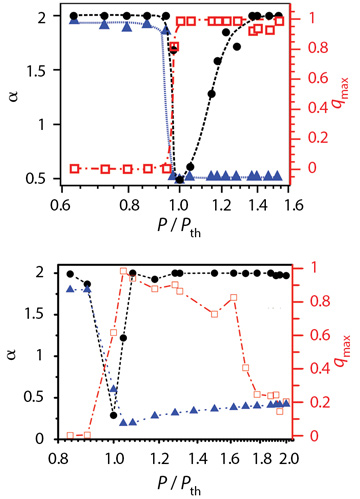 Transition from Gaussian (α = 2) to Lévy (0 < α < 2) intensity-fluctuation statistics (black curves) and from photonic paramagnetic (qmax = 0) to RSB spin-glass (qmax ≠ 0) phase (red curves), as a function of the normalized pump energy, occur simultaneously with the transition from pre-lasing to random-lasing behavior (FWHM, blue curves), in (top) a 1-D Er-doped random fiber laser with random fiber grating, pumped by a CW source, and (bottom) 3-D crystalline powders of Nd3+-doped YBO3 pumped by a pulsed Nd:YAG laser.
Transition from Gaussian (α = 2) to Lévy (0 < α < 2) intensity-fluctuation statistics (black curves) and from photonic paramagnetic (qmax = 0) to RSB spin-glass (qmax ≠ 0) phase (red curves), as a function of the normalized pump energy, occur simultaneously with the transition from pre-lasing to random-lasing behavior (FWHM, blue curves), in (top) a 1-D Er-doped random fiber laser with random fiber grating, pumped by a CW source, and (bottom) 3-D crystalline powders of Nd3+-doped YBO3 pumped by a pulsed Nd:YAG laser.
The recent exploitation of random lasers (RLs) as a photonic platform for studying complex systems, such as spin glasses, has opened new cross-disciplinary avenues for understanding RL behavior. RLs are cavityless systems, with a disordered gain medium and with feedback for laser action provided by strong light scattering. These lasers have two remarkable properties. First, strong RL intensity fluctuations present heavy-tailed Lévy distributions, which contrast with the Gaussian statistics apparent before lasing. Second, the tendency of the disorder to hamper synchronous mode oscillation produces a photonic spin-glass phase, with nontrivial correlations among modes, that is very distinct from the uncorrelated, paramagnetic-like regime below the lasing threshold.1
Recent theoretical approaches based on Langevin equations for the dynamics of the mode amplitudes have now unified the descriptions of these two phase transitions at the RL threshold.1,2 For the Gaussian-to-Lévy transition, the Lévy index, α, identifies the intensity distribution as Gaussian (α = 2) or Lévy (0 < α < 2). For the paramagnetic-to-spin-glass transition, qmax, a parameter that measures the overlap among mode amplitudes, phases or intensity fluctuations, can be used to characterize the photonic paramagnetic (qmax = 0) or spin-glass (qmax ≠ 0) phase. The presence of nontrivial correlations among RL intensity spectra emitted under identical experimental conditions (system replicas) leads to replica symmetry breaking (RSB) in the glassy phase.
In addition to providing this unified theoretical description, we have demonstrated the universality of such phase transitions in a wide variety of RL systems, including diverse pump sources, spatial structures and physical arrangements. Gaussian-to-Lévy and paramagnetic-to-spin-glass transitions simultaneously occur at the RL threshold, both for a 1-D fiber laser system3 and a 3-D solid-state system2 (see figure). The glassy transition concurrent with the RL threshold has also been characterized in a TiO2 particle-based dye-colloidal (3-D liquid) RL,4 and in a functionalized T5OCx oligomer in a 2-D amorphous solid-state RL.5
Researchers
E.P. Raposo, A.S.L. Gomes, P.I.R. Pincheira, B.C. Lima, S.J.M. Carreño, A.F. Silva and C.B. de Araújo, Universidade Federal de Pernambuco, Recife, Brazil
A.L. Moura, Universidade Federal de Alagoas, Arapiraca, Brazil
S.I. Fewo, University of Yaoundé I, Cameroon
L.J.Q. Maia, Universidade Federal de Goiás, Goiânia, Brazil
V. Jerez, Universidad de Investigación y Desarrollo, Bucaramanga, Colombia
M. Gagné and R. Kashyap, Polytechnique Montreal, Canada
References
1. F. Antenucci et al. Phys. Rev. Lett. 114, 043901 (2015).
2. A.S.L. Gomes et al. Sci. Rep. 6, 27987 (2016).
3. A.S.L. Gomes et al. Phys. Rev. A 94, 011801(R) (2016).
4. P.R.I. Pincheira et al. Opt. Lett. 41, 3459 (2016).
5. N. Ghofraniha et al. Nat. Commun. 6, 6058 (2015).
